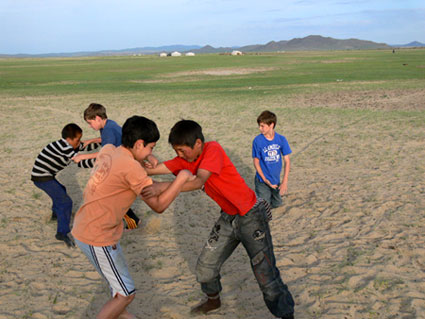Problem solving games, to understand the process of group problem solving.
Problem solving games in groups have multiple uses. They are simple games to use during trainings. You can use them as energizers, or you can use them to show the value of diversity in a group exercise.
Usually in a group problem solving situation participants have a tendency to look towards group members who they perceive to have leadership qualities. Fifty percent of the time it turns out they are as tongue tied as the rest of the group.
In such situations, it is the physical education teacher or the art teacher (I ususally work with school staff) who begins the process of helping the group to solve the problem.

On this page we will look at two such games.
1. Human Concentric Circles
2. Untangle
Let's look at the first game.
Problem solving game 1: Human Concentric Circles
1. Divide the group into two.
2. Ask one group to form a circle and hold hands. Call this circle group 1.
3. Ask the second group to form another circle outside the first one and also hold hands. Call this circle group 2.
4. So now you have two human concentric circles. The problem is to have the circles exchange places. That is the inner circle should become the outer circle and vice versa.
5. However, they have to achieve this without letting go of each others' hands.
6. You'll notice that it is the least likely person in the group who starts to make sense of the problem and starts to instruct the group on how they will work this out. Soon you'll hear the others piping up about possible moves.
7. There is considerable experimentation after every suggestion. Soon some moves turn out to be partly successful. These moves are followed through to completely solve the problem.
8. Once the groups have solved the problem ask them to interchange places again, but this time around they cannot use the same technique.
9. This whole problem solving game takes a few minutes. It highlights the issue of expertise to solve group problems lying in more than one person in the group. It also highlights an important aspect of problem solving - that there is more than one correct solution to a problem.
Let's look at the second game.
Problem solving game 2: Untangle
1. Make small groups of 6 or 8 people.
2. All members in the small group hold out their right hands and hold the right hand of the person opposite him/her.
3. They will stretch out their left hands and hold the left hands of someone else in the group, and not the same person. So, any one person is holding the hands of two other people with their right and left hands.
4. You'll see that the group is now all tangled.
5. The task for the group is to untangle themselves without letting go their grip with the two people in the group.
6. The untangled group will usually have alternate individuals facing inside and facing outside.
If you would like to know more about the use of these games in trainings use the
contact us form to send us your enquiries.
Return to Training Games
Also get a monthly e-zine 'Stories for EL' free for stories that you can use to emphasise experiential learning. Stories and their lessons are easily remembered.
They can also be used to communicate a concept effectively. They add the 'aha' or 'Eureka' or 'got it' factor to presentations and lectures. They are great tools to use in debriefs of games, to drive home a crucial point.
Fill in the form below and subscribe to the free e-zine.
[This website makes money for me, even while I give you all the information on it for free. Surprised?!!! Don't be. Want to know more about making a website like this one or even a better one and making money from it? Find answers to your questions
here .]




